Italy boast one of the strongest and most exciting teams for the upcoming Euro U21 tournament. They have a team full of stars of their generation with a lot of professional experience, among whom several have excelled in the best teams in the country recently.
Paolo Nicolato’s side come into the competition off the back of an impressive performance at the Euro U21 Championship Qualifying. They competed in Group F with Ireland, Sweden, Bosnia, Montenegro and Luxembourg, winning seven matches and drawing three. They did not lose in any of the matches, which was enough to comfortably lead the way with a playing style ideal for developing their key players.
Due to the positive results achieved by Italy, in this tactical analysis, we will detail in depth the ideas developed by Paolo Nicolato and the group of players who will travel to the tournament hosted by Georgia and Romania.
Predicted starting XI
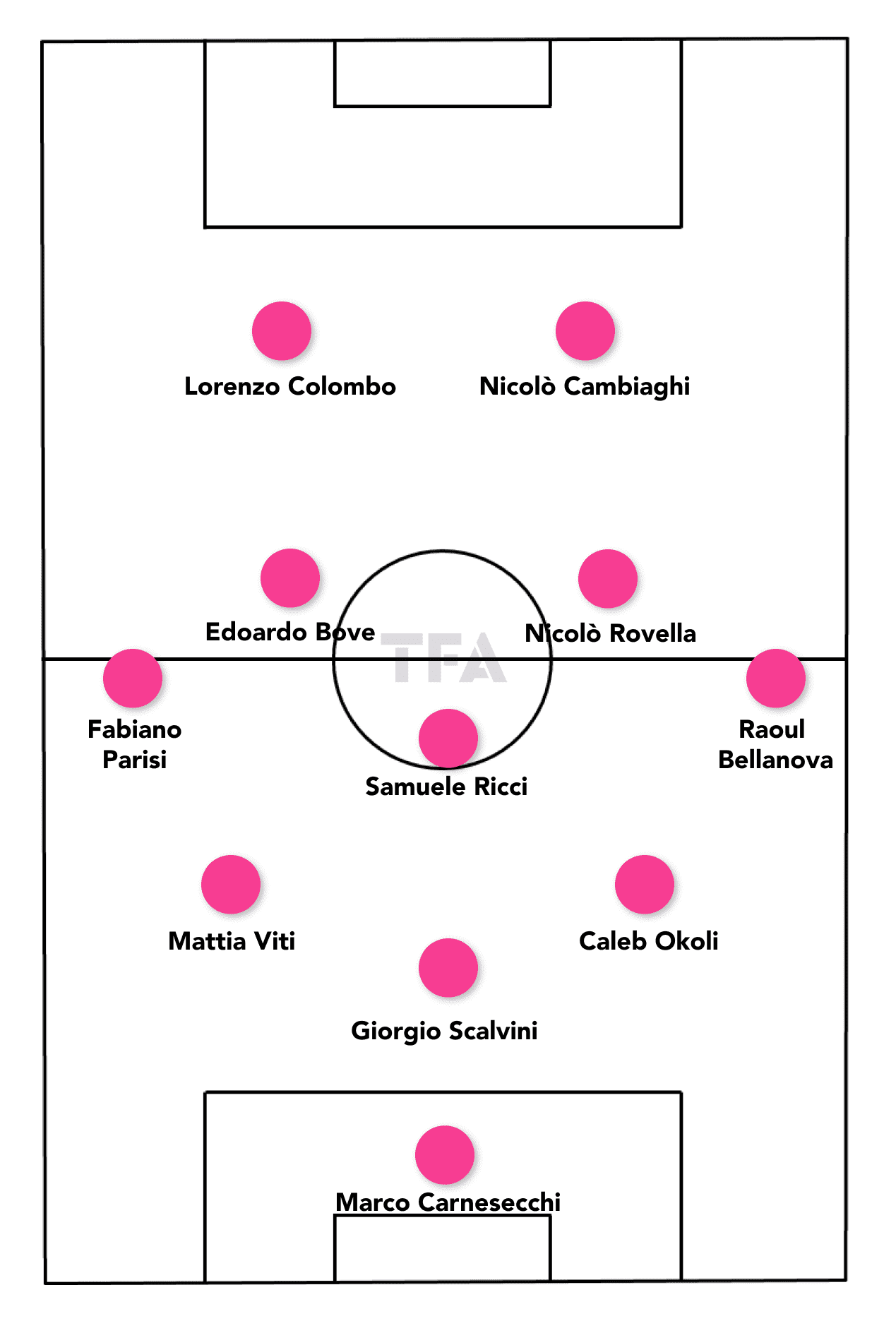
During their recent matches, Italy have been using the 3-5-2 system and have been able to enhance several of their players. It is a system widely used by several Serie A teams, so most of their players know it very well and know how to perform in different roles. With this system, the team is always looking to have width on both flanks via the wing-backs, midfielders at different heights to receive between the lines frequently and give more freedom to the centre-backs in the first phase.
Nicolato has tried many goalkeepers during his experience with Italy U21, but the one who has played the most games is Marco Carnesecchi, so expect to see him at the start of the tournament.
The team then usually uses a back three, which is expected to consist of Mattia Viti, Giorgio Scalvini and Caleb Okoli — centre-backs familiar with the system, powerful and with good notions of defending high, as well as good technical-tactical resources to be of great use in the build-up phase.
Raoul Bellanova and Fabiano Parisi are likely to be the wing-backs. Samuele Ricci has accumulated several games as a defensive midfielder and has been able to empower Nicolò Rovella, the star of the team, so that he has more freedom to move around the midfield creating passing lanes and dangerous chances. Left central midfield is the position where there are perhaps more doubts, as many players have been tested, but Edoardo Bove could be the one.
Lorenzo Colombo and Nicolò Cambiaghi are two of Nicolato’s most used attackers. The first is a very powerful physical number nine, while the second is a profile more focused on the second striker role to appear on the wing on many occasions and attack the box with a lot of speed. They are a complementary pair who understand each other’s playing styles very well.
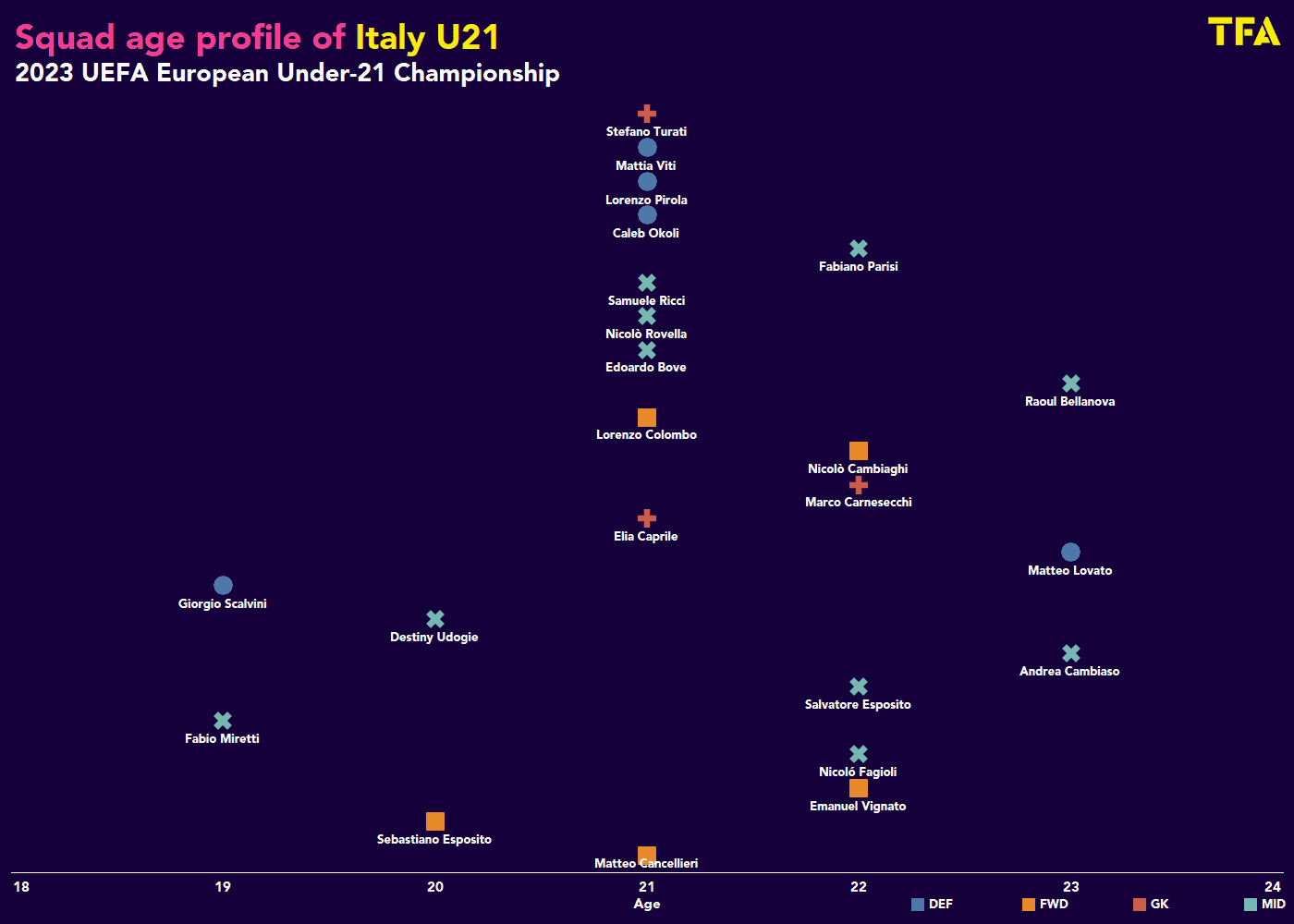
Attacking phase
Italy are a possession-based team, always looking to control the tempo of the game and therefore their opponents. Throughout all their matches to reach this competition, they have dominated their opponents through possession, from those well below their level to other big teams such as Germany and England.
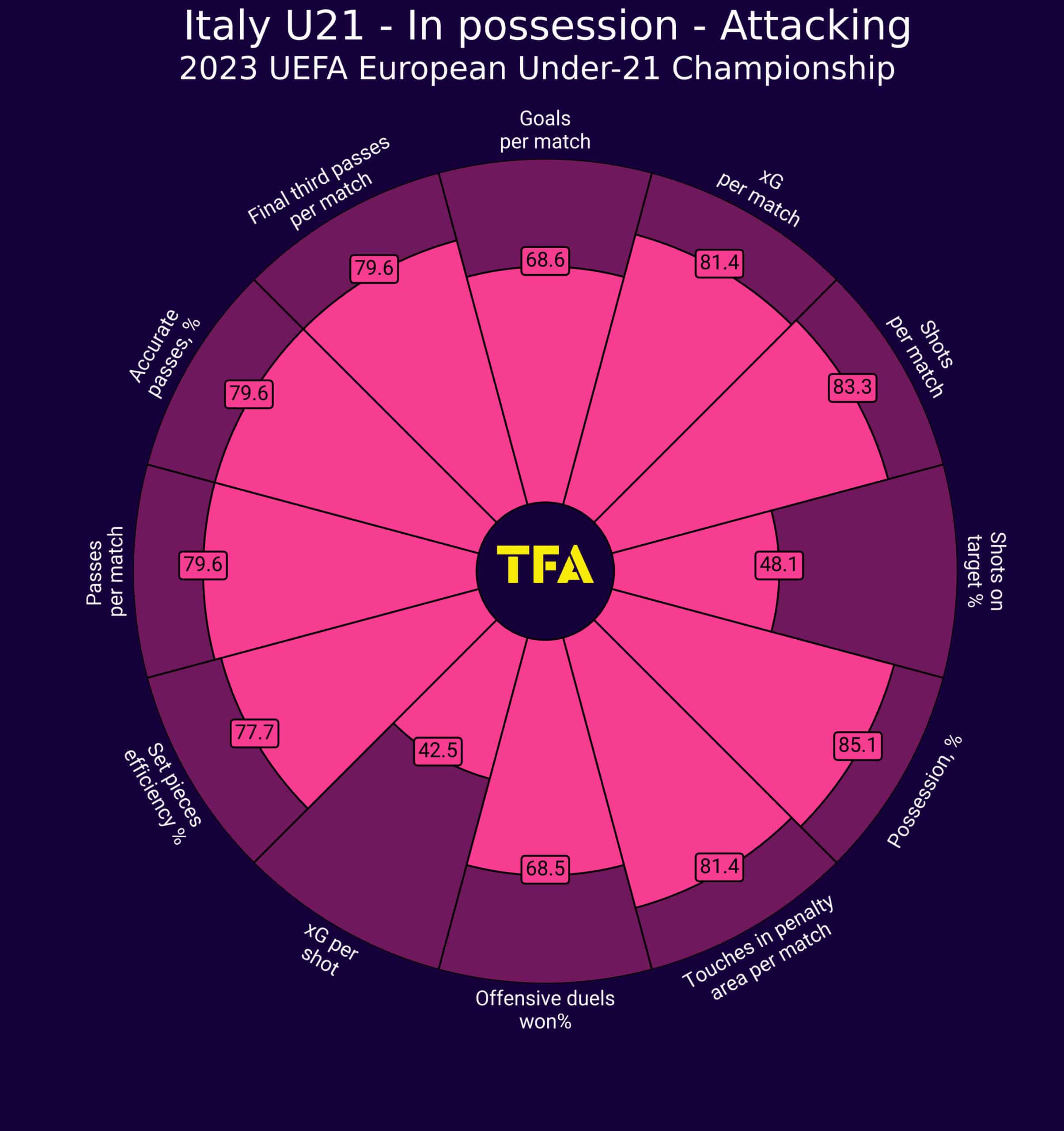
Paolo Nicolato seeks to be patient in the build-up phase; the goalkeeper gives short passes to the centre-backs and they initiate play. Generally, they tend to use the right flank as a strong side, where Caleb Okoli or Giorgio Scalvini can play, two players with a great passing range to attract pressure and break lines by connecting with players in different areas.
Once the ball reaches the right or left centre-back, two scenarios emerge: the opponent presses high or, on the contrary, the opponent moves back a few metres to solidify their lower-middle block.
The first scenario is usually the one that benefits Italy the most, as their centre-backs excel in their passing range, while the mobility of their midfielders is of great help — while some lure or draw opponents out of the area, the others position themselves in the free spaces and manage to make progress after receiving.
In addition, they have developed very good dynamics by dropping the wing-back on the active side to make the one-two so that the centre-backs can progress.
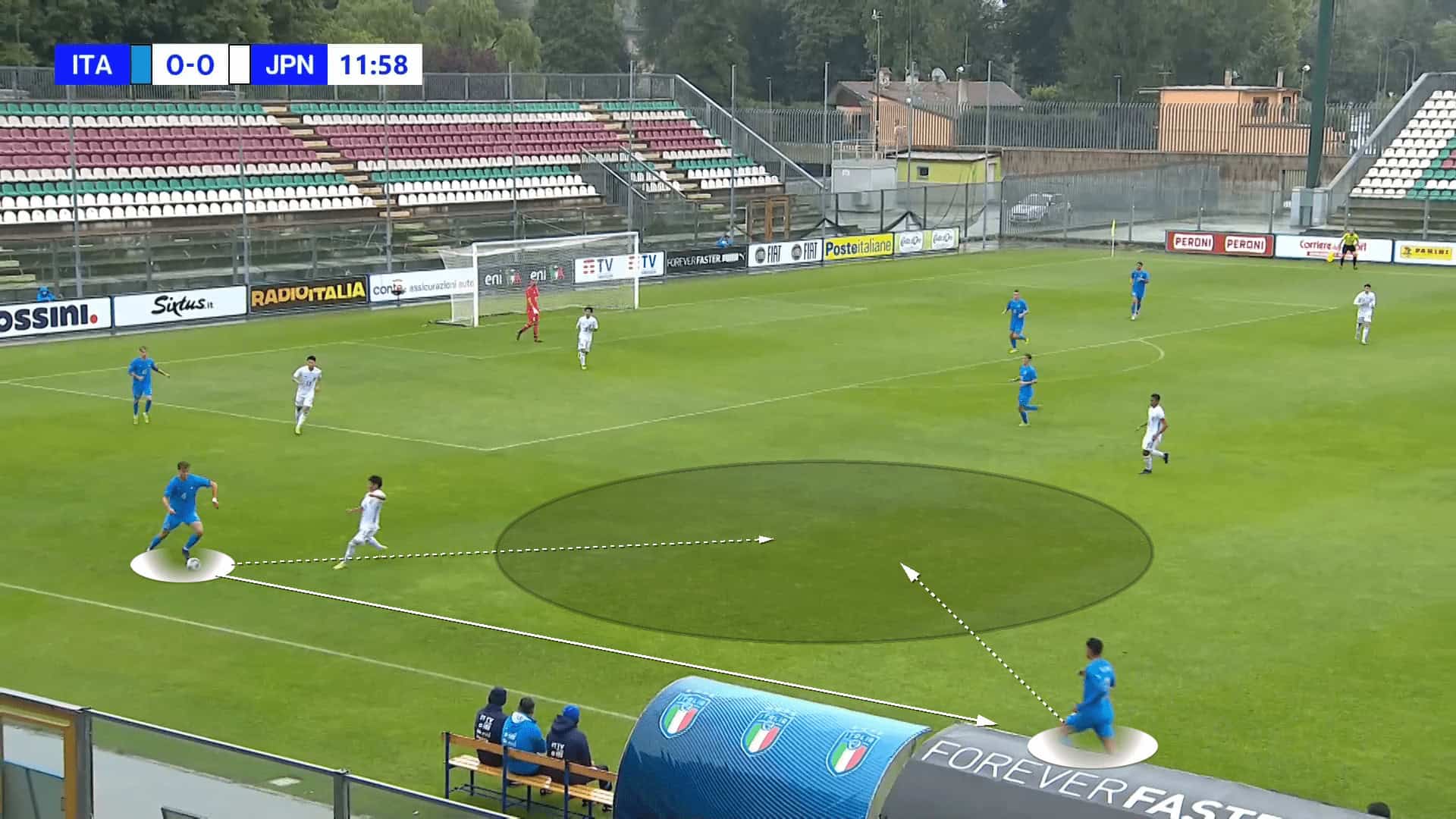
If the opposing team drops back, the centre-backs can carry the ball and always have the option of passing to the wide wing-back or connecting with long passes with one of the centre-forwards making unmarked moves to attack the box.
Italy’s creative organiser is Nicolò Rovella, undoubtedly the most important player in the game. He is a player who has been used in different positions throughout the process, either as a defensive midfielder or right central midfielder — in either position, he is usually focused on controlling the tempo of the game.
He is a player with great mobility behind the opposing front line, very resistant under pressure, so the team gets many benefits after connecting with him behind the opposing first line, as his ability to turn and pass selection is ideal to improve the quality of attacks.
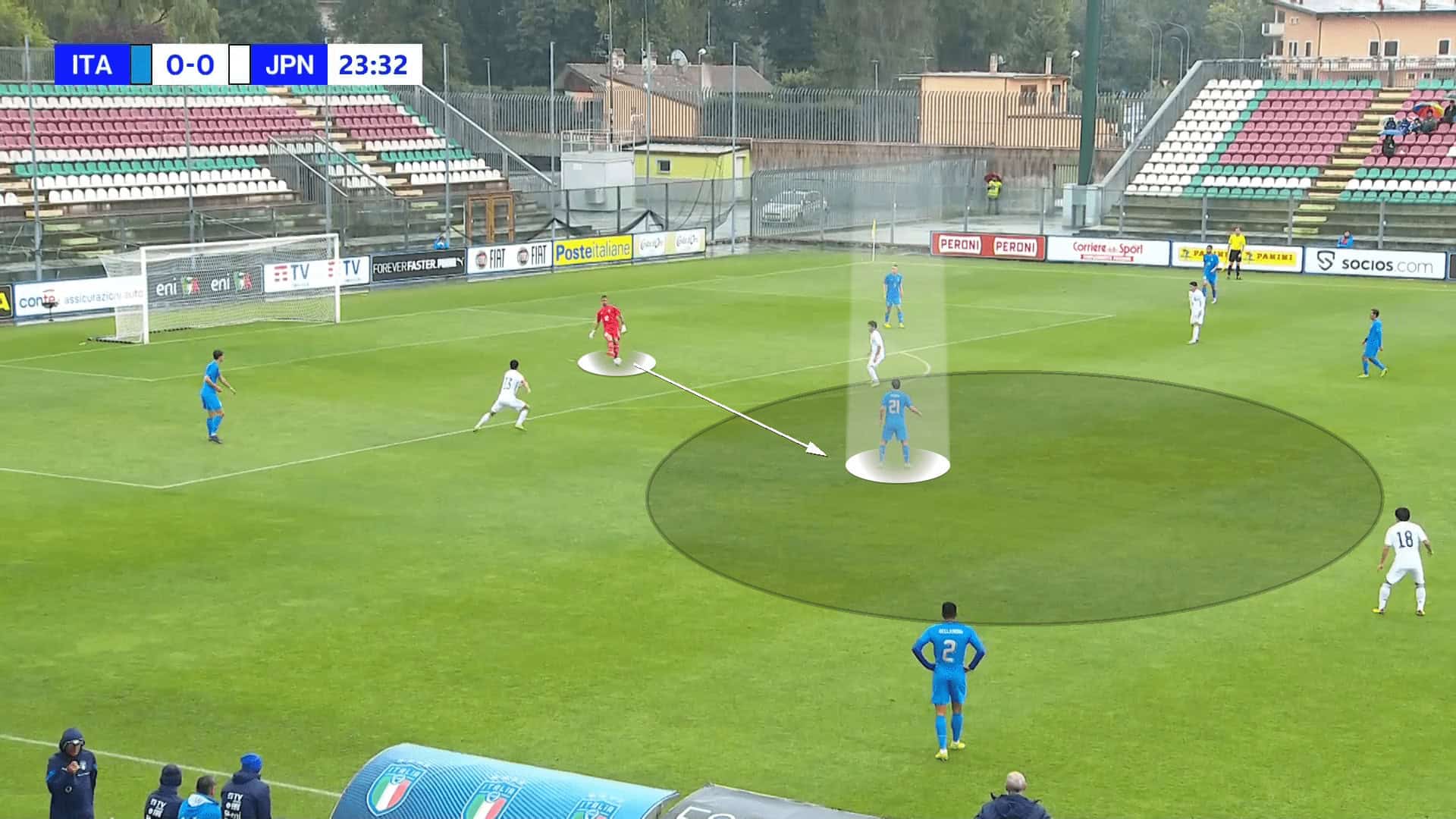
One of the advantages of the system is shown when Rovella receives in midfield, manages to turn and always has two wide passing options, players between the lines (his two team-mates in midfield or one of them and a centre-forward dropping back) and others focused on attacking the last line through aggressive dismarking movements.
In addition, he is a very clever player to circulate side-to-side, which benefits greatly when he receives from the right to connect with the isolated wing-back on the left with time-space.
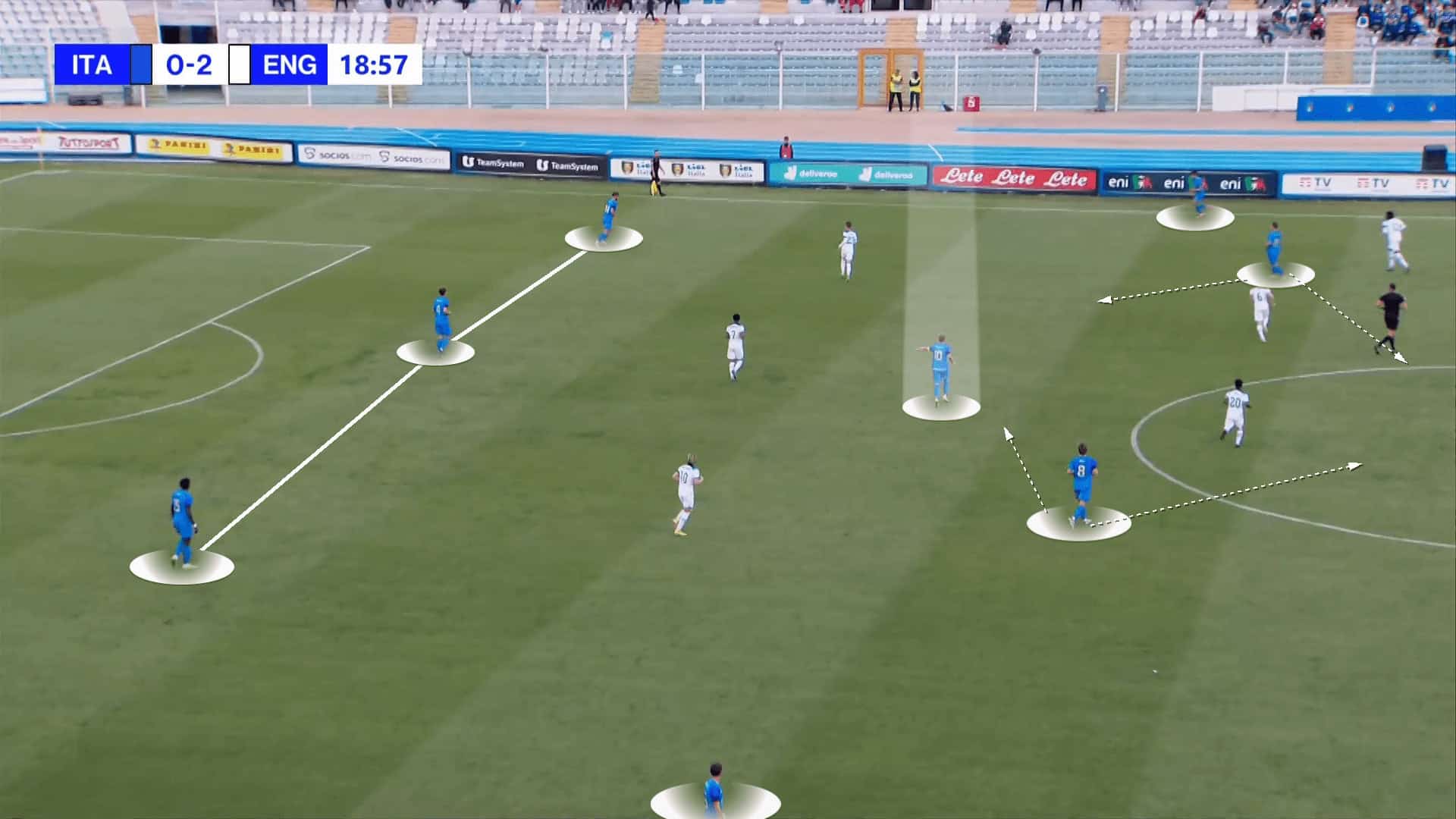
Italy’s wing-backs are noted for their speed, but Fabiano Parisi brings an extra dimension to this, being a very technical player to change direction and play on the inside as well. With him, the team manages to dynamise their attacks in different ways and not always look for 1v1s on the wing or being played away into space. However, they all manage to gain advantages when they receive with time and space by setting the width on the weak side.
The team benefits the most from the passing range of their centre-backs and the movements of their centre-forwards to create passing lanes, as the receiver can then rely on the right wing-back or left wing-back in space to get forward.
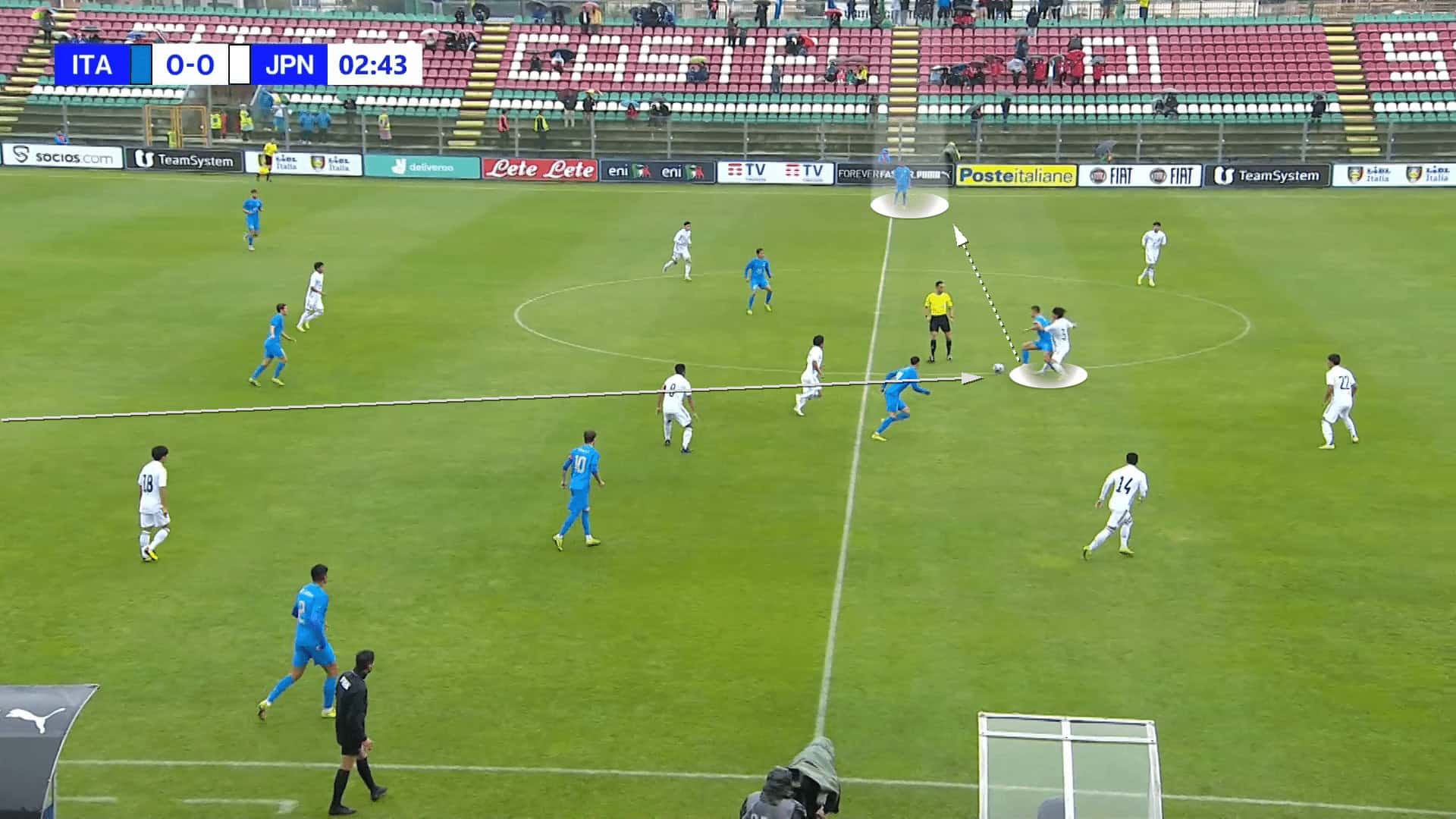
Overall, Paolo Nicolato’s Italy is a team developed with a lot of sense — they have sought to enhance individual profiles through the system and have achieved a lot of consistency in their approach.
With so many intelligent players to play between the lines and distributors with great passing range, they can break opposition lines very often and dynamise attacks from the inside. However, they also have very good mechanisms for getting forward on the outside, which translates into an ability to adapt according to what the opposition are looking to prioritise in their cover.
Defensive phase
Italy is a team that focuses on high pressing. They make very aggressive and coordinated collective efforts to execute targeted pressing to get the centre-backs to the flank and once there, to get as close as possible and force them into mistakes or long passes.
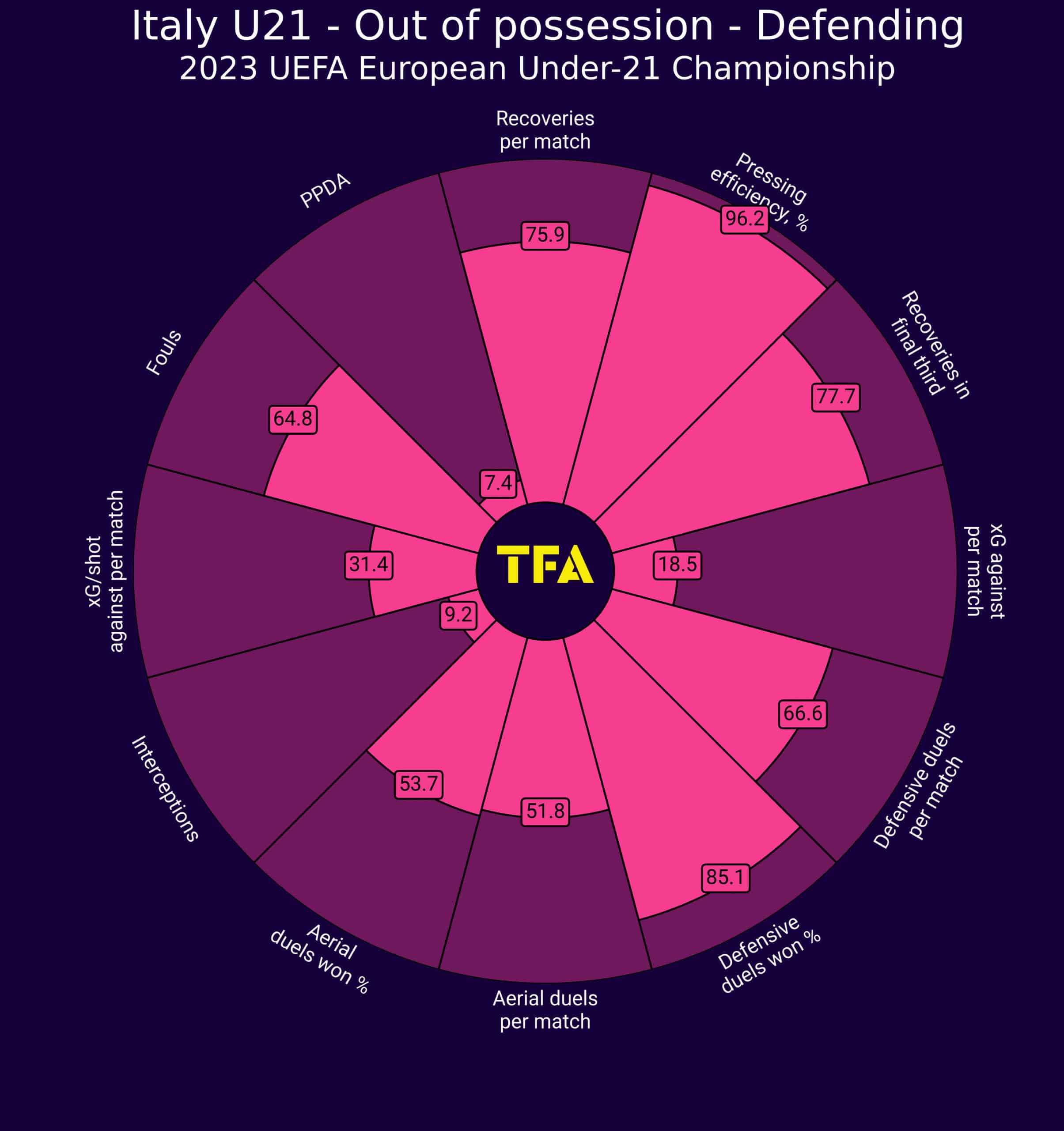
The coordination with which the team presses is remarkable, especially during the first few minutes, where the collective energy is much greater. There is good timing, in general, to direct the centre-backs towards the flanks and then accelerate as much as possible to reduce their options for progression, managing to steal on a large number of occasions in the opposition half, especially when the ball-holder is looking to break the lines of pressure.
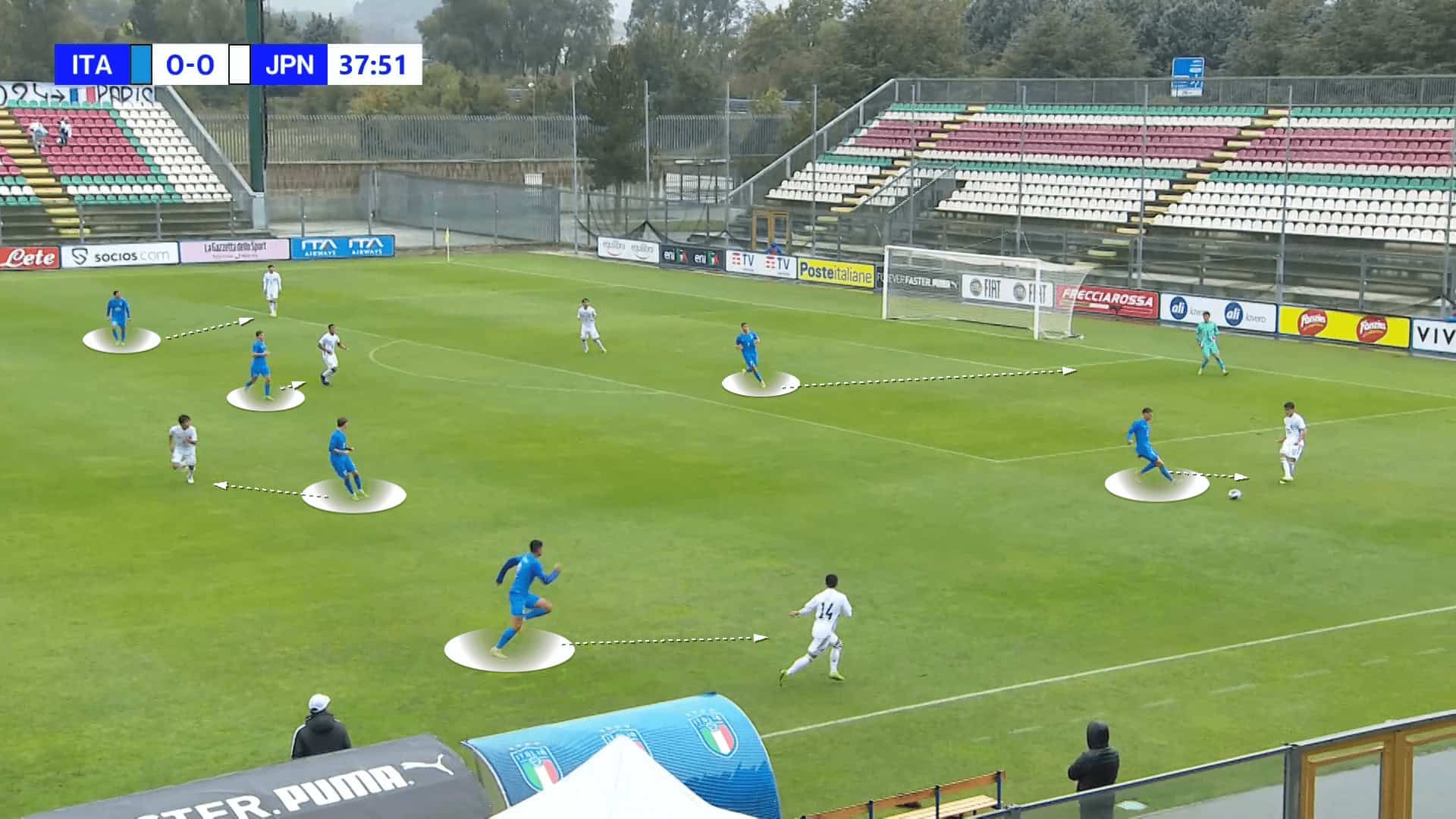
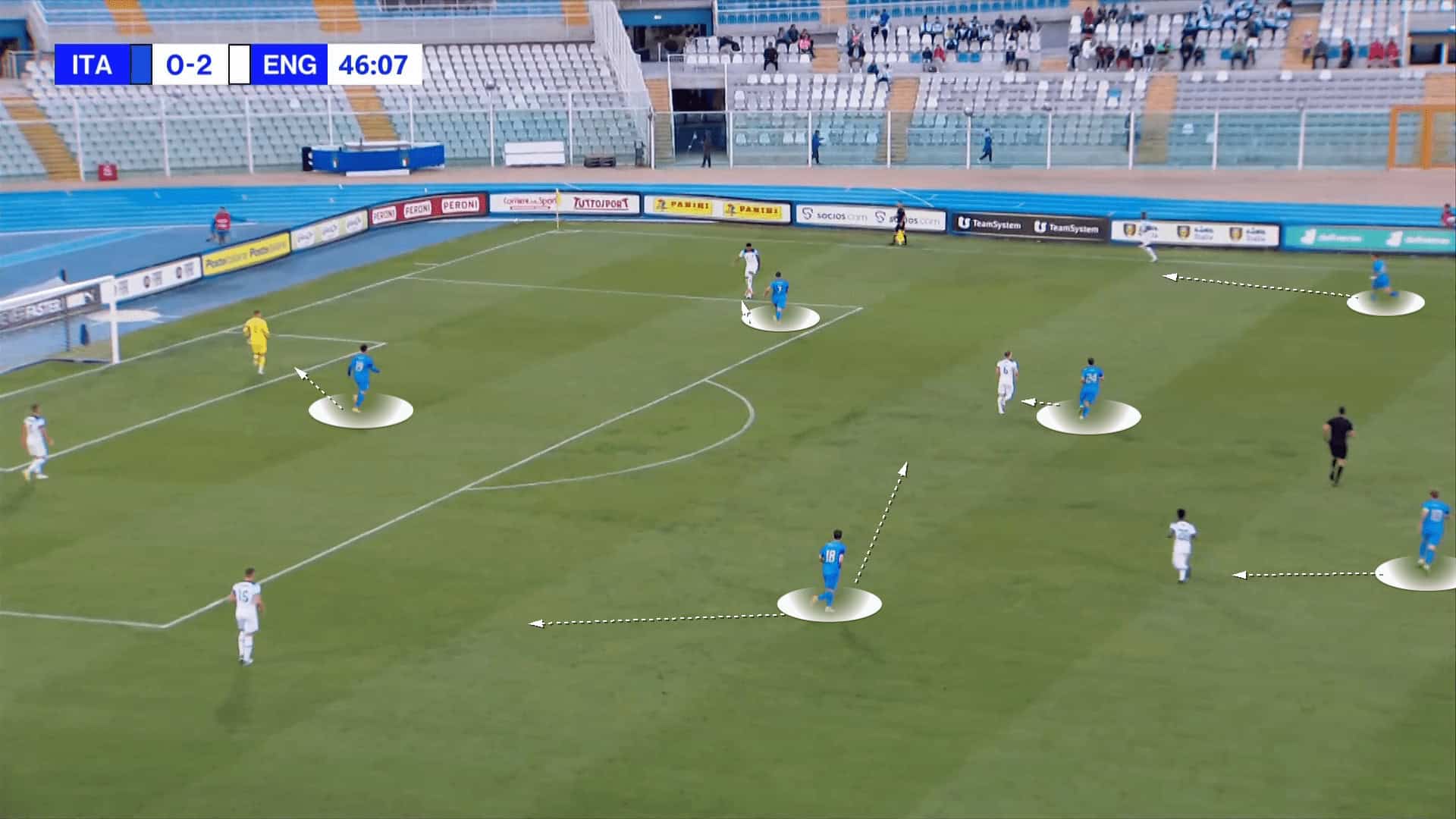
However, the pressure becomes less effective as the minutes go by because the energy and intensity with which it is developed is lower. In addition, one solution to targeted pressure could be to push the full-backs a little deeper so that the Italian wing-backs’ trajectory is bigger and more space is created behind their backs, where the wing-backs could appear and thus also push the Italian centre-backs out of their zone. However, these are intentions with great risks, as the Italian pressure is really good and their defenders can come out of the zone with a lot of power.
In large part, Italy’s high pressing is sustained by their centre-backs. They are players who are familiar with the system, very powerful physically and have good concepts for playing in a high defence. Okoli and Scalvini are very solid players in duels and also in the air, so opponents will not have a “solution” to the high pressure simply with long passes.
There are not exactly few teams in modern football that seek to attract pressure in order to progress and develop good dynamics of progression in the build-up phase, and this tournament will be no exception. In the match against England, Italy suffered in several sequences from accumulating players on the inside to create multiple passing lines with third-man concepts or very quick triangulations.
The team’s off-the-ball performance has been very positive over the last few years, to the point of being considered one of the team’s great strengths, but a system so based on high pressing in such a short and intense tournament can be a risk.
Transitions
Italy is a team with midfielders who are very clever at controlling the tempo of the game. Once the team regains the ball near the centre circle, they have players who know very well when and how to pause the play in order to have more dominance in the opposition half or, on the contrary, what they should do to speed up the play and take maximum advantage of the spaces in the opposition block.
In addition, Paolo Nicolato’s team tends to benefit the most from restarts, especially when the opposition press high. In this way, they manage to draw opponents in, widen the spaces between the lines and then progress more aggressively.
In defensive transitions, Italy is a very aggressive counter-pressing team. Whenever the team loses the ball in the opposition’s half, they seek to win it back as quickly as possible through very aggressive collective movements so that the opponent does not have much time to decide and is forced to make a mistake.
In this sense, the team is quite effective, but they could also improve the occasions when they have to drop back or focus on controlling passing options and not just anticipating them in order to better adapt to the passing of the minutes with better management of fatigue.
Attackers
In this area, Italy have profiles that fit the idea, especially to play in a double forward line that gives their players the freedom to come out of the area, create space inside or appear on the wing and then make aggressive unmarked moves into the box.
Lorenzo Colombo is a player who has played 16 games for Italy U21 and has played in all the youth teams in the country. He is a very strong player, with excellent postures to hold opponents at his back and can even be used as a target man. He is also very useful for creating passing lanes inside and then activating a wing-back in freedom.
At the same time, he often plays with profiles like Nicolò Cambiaghi, a very explosive player in his movements and with more freedom to appear in different areas of the pitch.
Midfielders
The midfielders form the best line of this Italy U21. The team combines the talents of players like Nicolò Rovella, the great creative organiser and leader of this team, with players like Samuele Ricci and Eduardo Bove/Nicolò Fagioli to control the tempo of the game and gain advantages by being a possession-based team.
The team has several very energetic players with technical-tactical resources to improve the quality of attacks in almost every action. In addition, there are profiles very useful for their passing range and maturity in decision-making (Rovella or Ricci) with others very useful to gain presence between the lines and create passing options to progress (Bove or Fagioli).
Defenders
The system used by Italy would not be possible without having defenders so well adapted to a high defence and with plenty of resources to lead the build-up phase. The starting back three is expected to consist of Mattia Viti, Giorgio Scalvini and Caleb Okoli, three physically strong CBs with good concepts to defend several metres outside their area.
In addition, they are all players with excellent passing range and good technique in general, so they can carry the ball and progress a long way down the field against opponents with a low-mid block or who leave large spaces between their lines.
Like the midfield, it is a line where Italy has players with a lot of experience and maturity, something that always makes a big difference in this type of tournament.
Key player
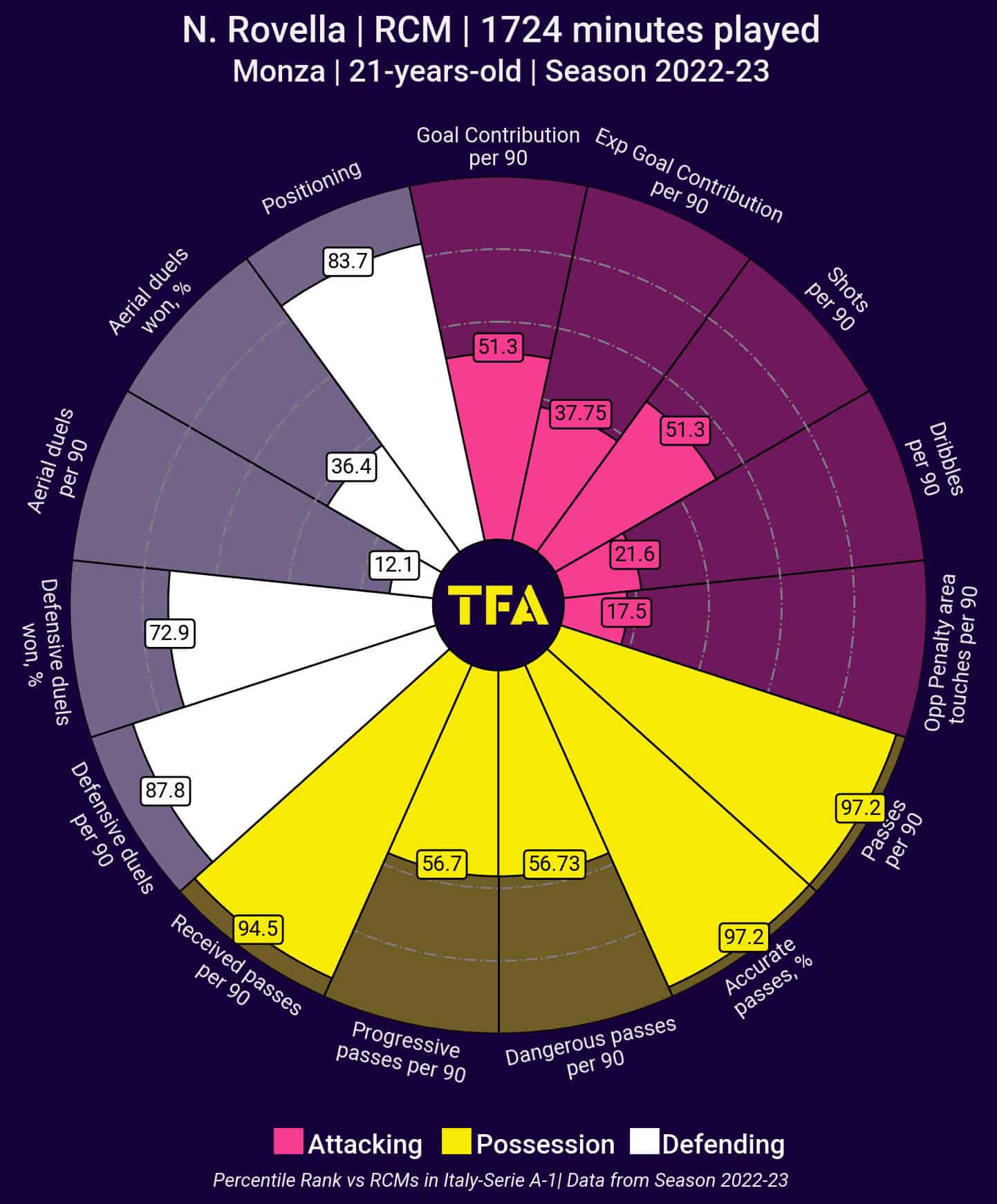
The best and most important player of Italy U21 is Nicolò Rovella. He is the leader of the team and the player who controls the tempo of the game. At the same time, he is one of the players who tends to intervene on most occasions and shows excellent decision-making.
Throughout the process, he has played as a defensive midfielder and also as a right central midfielder, but he is always a player with very intelligent mobility behind the first line of pressure and who exploits to the full his vision and passing range to distribute. However, Ricci’s presence could give him more freedom and impact in the opposition half, often creating dangerous chances.
He is one of the most interesting players in the tournament and one of the players who shines most for his technical-creative quality, but also for the intelligence he shows in all phases of the game.
Tournament prediction
Italy have a team that could compete for the title. Group D, where they face France, Switzerland and Norway, is one of the toughest, but they are undoubtedly one of the teams most capable of being protagonists in this edition of the Euro U21.
Beyond all the individual quality and success of the recent game idea, they are also one of the most mature teams through the experience of their players in professionalism, one of the most valuable aspects in this type of tournament.
Paolo Nicolato’s Italy is one of the most interesting teams to enjoy during the upcoming Euro U21. They did not lose a single match during the qualifying round and come in as one of the favourites.
The game plan has empowered many players to perform at their best and has been solidified during the team’s recent matches, but it will be a challenge how a team so aggressive in their intentions can manage the energy needed to maintain such a high tempo throughout the competition.
However, there is no doubt that they have the individual and collective ability to achieve a great result in Georgia and Romania.

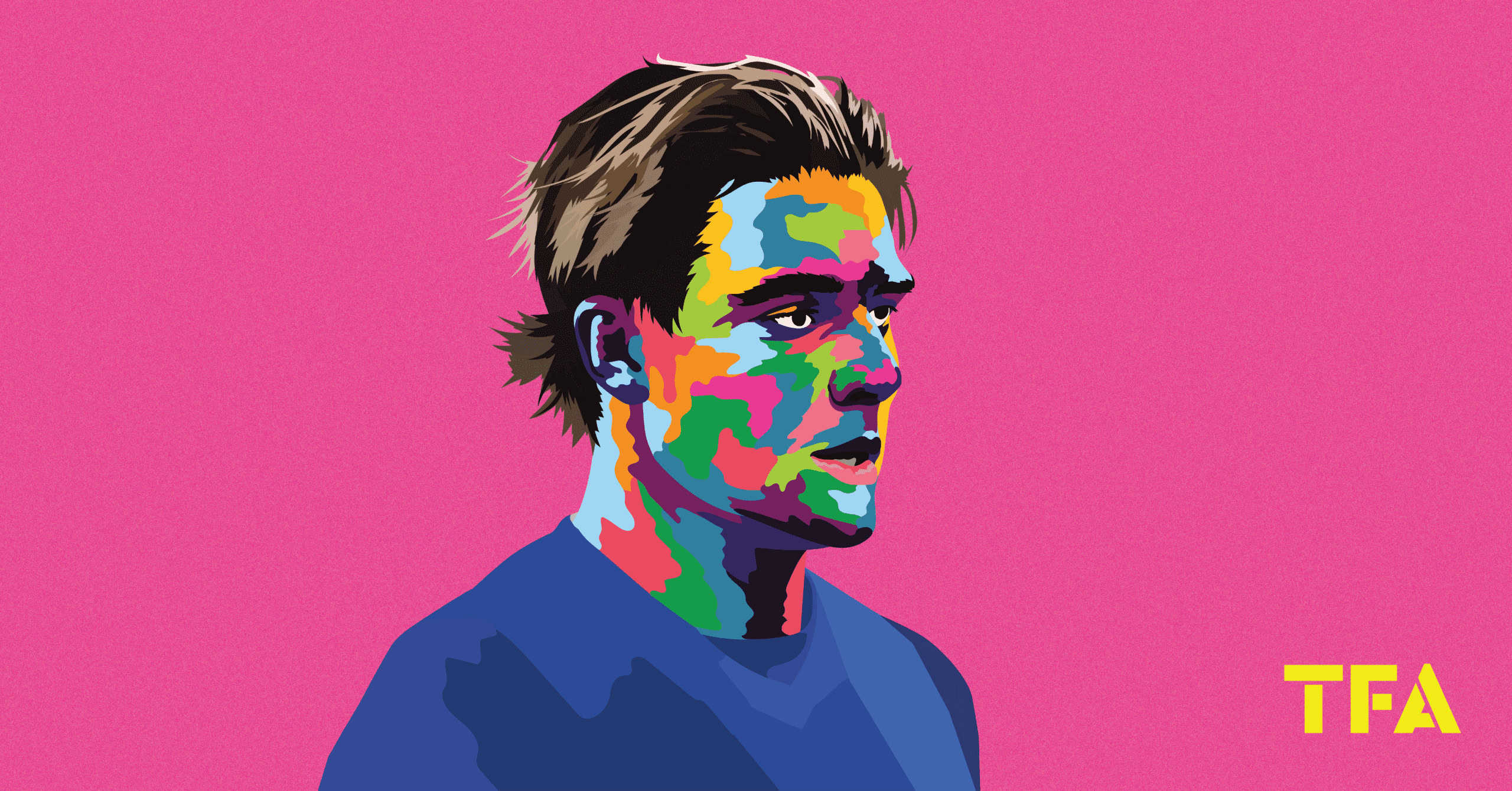



Comments